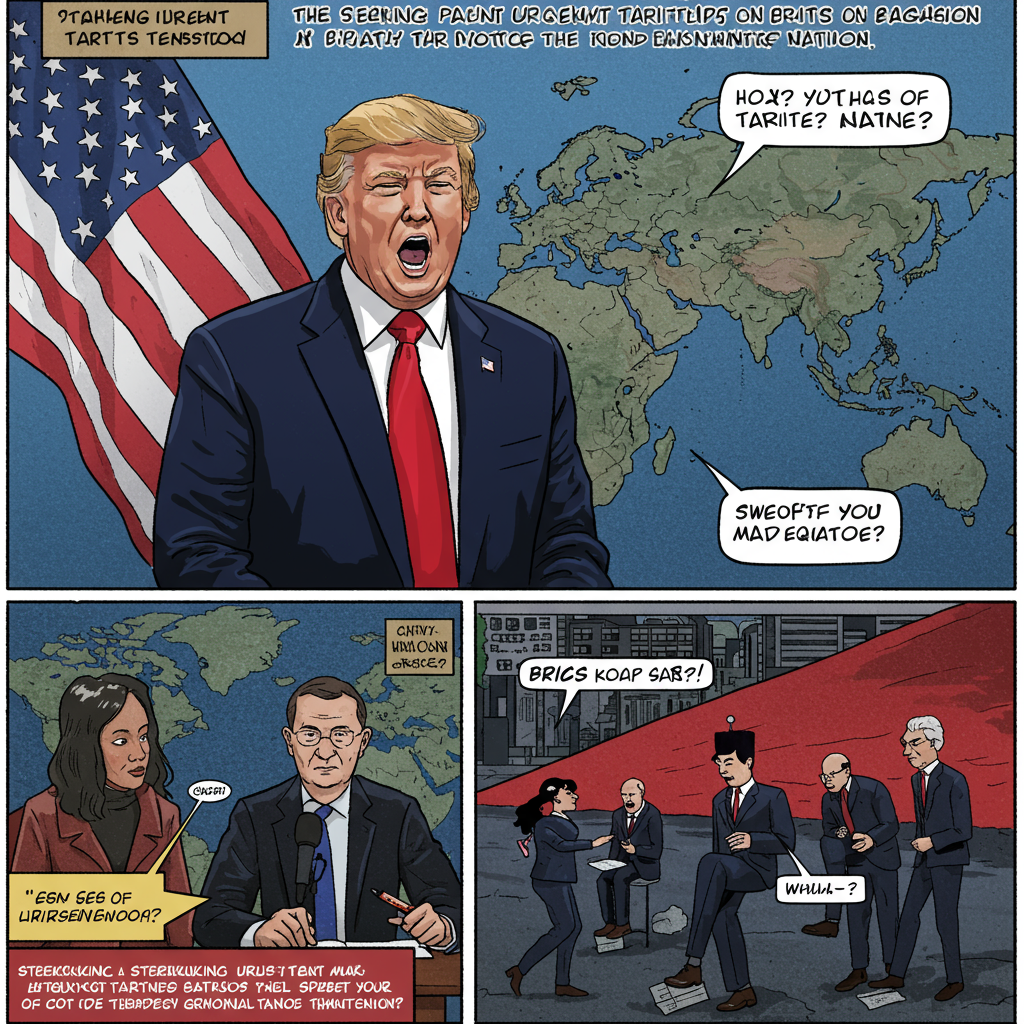Geopolitical tensions flared on the final day of a key brics summit as Brazilian President Luiz Inacio Lula da Silva launched sharp criticism against former U.S. President Donald Trump. The rebuke came after Trump threatened new tariffs targeting the emerging market bloc and other nations. Lula labeled Trump’s public tariff threats “irresponsible,” echoing similar sentiments from south Africa, which hosted the gathering.
This escalating spat highlights the growing economic divide between the BRICS nations and the United States. Lula’s comments underscored the bloc’s frustration with the use of trade policy as leverage. The Brazilian leader’s remarks also reinforced the BRICS group’s shared ambition to reduce its reliance on the U.S. dollar in international trade, a long-standing goal gaining renewed urgency amidst trade disputes.
Trump’s Broad Tariff Offensive Detailed
The catalyst for the BRICS leaders’ ire was a series of social media posts from Donald Trump detailing plans for significant new import duties. These announcements, made via Truth Social, included specific tariff rates targeting a range of countries. Signed letters outlining the new rates were reportedly sent to leaders in South Korea, Japan, Malaysia, Kazakhstan, South Africa, Laos, and Myanmar. Vietnam was also mentioned with a proposed 40% tariff rate.
Specific rates varied by country, including 25% on goods from Japan and South Korea, 25% on Malaysia and Kazakhstan, 30% on South Africa, and 40% on Myanmar and Laos. These duties were described as blanket tariffs, potentially layering atop existing sector-specific duties. Critically, Trump’s announcement included a potential additional 10% tariff specifically on countries aligned with the BRICS bloc. This direct targeting of the group appears to have significantly heightened tensions at the summit. The new tariffs are slated to take effect on August 1, 2025, a delay from a previous deadline, according to White House press secretary Karoline Leavitt.
BRICS Leaders Push Back on Trade Pressure
During the summit session in Rio de Janeiro, President Lula did not mince words. He directly criticized Trump for making significant economic policy threats publicly on social media. Lula views such actions as destabilizing and detrimental to predictable international trade relations. The sentiment was shared by other BRICS participants, including South Africa’s President Cyril Ramaphosa, who also publicly pushed back against Trump’s proposed tariffs.
This unified stance from key BRICS members underscores their collective resolve to counter what they perceive as unilateral economic pressure from the United States. The targeting of South Africa, a BRICS member hosting the summit, with a 30% tariff rate, alongside the potential additional 10% BRICS-wide tariff, likely amplified the sense of affront among member nations. The exchange underscores the BRICS group’s evolving role as a counterweight to Western economic influence.
The Drive for De-Dollarization Intensifies
Lula’s criticism of Trump’s tariff threat was coupled with a strong call for world leaders to explore alternatives to the U.S. dollar for international trade settlement. This call aligns perfectly with a core objective of the BRICS bloc. Member nations have been actively discussing and implementing strategies to conduct trade in their local currencies, bypassing the dollar.
Reducing Currency Risk and US Influence
The push for de-dollarization within BRICS is driven by several factors. It aims to reduce exposure to U.S. monetary policy shifts and the potential impact of U.S. sanctions. By trading in local currencies or exploring alternative payment systems, BRICS countries seek greater economic autonomy and stability. Trump’s use of tariffs as a foreign policy tool likely reinforces the bloc’s determination to lessen dependence on the dollar-dominated global financial system. This strategic move is seen as a long-term effort to reshape the global economic landscape.
Immediate Global Market Reaction
President Trump’s tariff announcements sent immediate ripples through global financial markets. On Monday, July 7, major U.S. stock indices experienced a notable sell-off. The Dow Jones Industrial Average dropped over 420 points, reflecting investor anxiety over renewed trade tensions. The S&P 500 and Nasdaq Composite also registered declines, indicating broad market pessimism.
Sector-Specific Impact
Companies with significant exposure to the targeted countries saw their share prices fall sharply. U.S.-traded shares of Japanese automakers like Toyota and Honda declined around 4%. South Korean companies also faced pressure, with SK Telecom dropping over 7% and LG Display falling more than 6%. Even major U.S. tech giants like Apple, Alphabet, and AMD shed over 2%, highlighting the interconnectedness of global supply chains. Nvidia, a bellwether for tech, saw slight losses.
Currency and Commodity Volatility
The U.S. dollar strengthened significantly against a basket of global currencies, reaching its highest level in over a week. Currencies of targeted nations, particularly the Japanese Yen and South Korean Won, sank sharply against the greenback. The Won traded at its lowest level in two weeks. South Korean assets overall plunged, with one key ETF tracking the market falling 3.6%. Commodity markets also reacted; copper and other industrial metals extended losses, partly attributed to the uncertainty created by the BRICS tariff threat. Gold, typically a safe-haven asset, pared earlier losses as investors sought refuge from market volatility.
Broader Economic Landscape and Future Outlook
The tariff announcements arrived amidst other significant global economic developments. Oil prices rose, supported by Saudi Arabia’s unexpected price hikes for crude, suggesting confidence despite potential demand impacts from trade wars. Discussions around major IPOs like Figma continued, signaling shifts in the tech market. Reports from the Federal Reserve hinted at ongoing interest rate uncertainty. The U.S. Treasury prepared to issue billions in bills to rebuild its cash reserves, a move expected to influence short-term yields. European natural gas prices saw slight increases as traders assessed the potential downstream effects of U.S. trade policy on global demand and energy strategy. A U.S. Energy Department report also raised concerns about future power grid stability due to energy transition policies, adding another layer to global economic and energy discussions.
Treasury Secretary Scott Bessent’s confirmation that more trade announcements were expected within 48 hours further amplified market anticipation and uncertainty. The confrontation between the U.S. and the BRICS bloc over trade policy, marked by Lula’s strong words and Trump’s specific tariff threats, signals a period of continued geopolitical and economic friction. The BRICS group’s response, particularly its intensified focus on de-dollarization, indicates a strategic shift aimed at building resilience against such external pressures.
Frequently Asked Questions
What exactly did Trump threaten regarding BRICS tariffs?
Former U.S. President Donald Trump’s threat involved plans for significant new tariffs, announced via social media posts. While specific rates were detailed for various countries (including a 30% tariff on South Africa), he also mentioned a potential additional 10% tariff specifically targeting countries aligned with the BRICS bloc. These proposed tariffs are scheduled to become effective on August 1, 2025.
How did global markets react immediately to these new tariff threats?
Global financial markets showed immediate negative reactions. Major U.S. stock indices like the Dow Jones, S&P 500, and Nasdaq saw significant declines. Shares of companies with exposure to targeted countries (like Japanese automakers and South Korean tech firms) dropped sharply. The U.S. dollar strengthened, while currencies of targeted nations, such as the Japanese Yen and South Korean Won, weakened considerably. Commodity prices for industrial metals like copper also fell.
Why are BRICS leaders like Lula pushing for reducing reliance on the US dollar?
BRICS leaders advocate for reducing reliance on the U.S. dollar in international trade primarily to gain greater economic autonomy and reduce vulnerability to U.S. foreign and monetary policy. Actions like unilateral tariff threats and potential sanctions demonstrate the power the U.S. wields through the dollar’s dominance. Shifting to trading in local currencies or alternative systems aims to mitigate currency risk and insulate member economies from external economic pressures.
Conclusion
Brazilian President Lula’s strong condemnation of Donald Trump’s tariff threats during the BRICS summit underscores the deepening economic rivalry between the U.S. and the influential emerging market bloc. Trump’s specific, targeted tariff proposals, including a potential extra duty on BRICS-aligned nations and a significant rate on South Africa, ignited fury among member states. This tension is not merely political; it has tangible impacts, immediately triggering market volatility across stocks, currencies, and commodities globally. The BRICS response, particularly the renewed push for de-dollarization, signals a strategic pivot towards building a financial infrastructure less dependent on the U.S. dollar. As more trade announcements are anticipated, the world watches how these economic confrontations will reshape global trade dynamics and financial systems.



